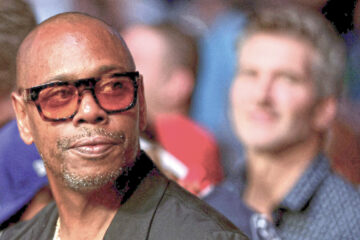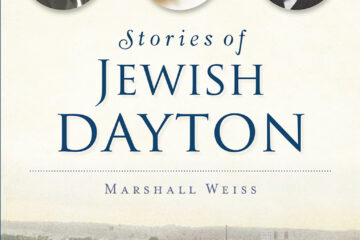Connections to the 1913 flood
How the Great Dayton Flood shifted the course of Jewish life here

By Marshall Weiss, The Dayton Jewish Observer
For nearly three days, the Israel family huddled on the roof and in the attic of their home, 241 Sycamore St. in Dayton. Trapped above the waters March 23-25 during the Dayton Flood of 1913, the Israels — parents Margaret and Herman, children Thelma and Henry — subsisted on water out of the tank of their toilet, which was high up on the wall.
“They sat up on their roof and in their attic for three days before a boat came and got them,” says native Daytonian Charles Jenefsky, 83, Thelma’s son.
A source of comfort to Margaret during that time was her copy of the Union Prayer Book. This was the prayer book in use at the family’s house of worship, Temple Israel, Dayton’s Reform Jewish congregation.

On the title page of Margaret’s prayer book, she wrote, “This book went thru (sic) the Dayton flood March 25 — 1913. It was a good companion thru the days we spent in the attic at 241 Sycamore St.”
“I got the book from my mother, and it was her mother that wrote that, when my mother was a child,” recalls Jenefsky, who splits his time between Tucson and Dayton.
Margaret Israel’s prayer book is among the artifacts on display at the Dayton Art Institute through May 5 in commemoration of the centennial of the flood.
The flood — and the resulting fires and sickness in its aftermath — killed more than 360 people and displaced nearly 65,000 people from approximately 20,000 homes that were destroyed.
Along with the tens of thousands of Daytonians whose lives were turned upside down by Ohio’s worst flood on record were approximately 3,500 Jews.
Those Jews of German origin, who first settled in Dayton in the 1840s, made lives for themselves as merchants. They tended to live downtown and worshiped at Temple Israel, then located at First and Jefferson Streets.
Jewish immigrants from Eastern Europe, who began arriving in the 1880s and continued to settle in Dayton by the dozens each month, lived in Southeast Dayton, around Wayne and Wyoming Streets.
Russian Jews prayed at Beth Jacob Synagogue on Wyoming Street between Brown and Wayne.
Lithuanian Jews attended Beth Abraham Synagogue, which in 1913, had just purchased a “small frame building” on Wayne Ave. after “wandering from hall to hall on Fifth Street for many years.”
A rented two-story house next to Heller’s grocery at the corner of Richard and Clay in Southeast Dayton was in 1913 the home of Beth Abraham’s Rabbi Samuel Burick, his wife, Lillian, and their three children at the time: Si, Lee, and Gertrude.
Si would become a celebrated sportswriter for the Dayton Daily News. In a 1971 column, Si Burick recalled how his family was rescued from the flood:
“My mother’s uncle Chaim Shlomo Cohen, who peddled fruit from a horse and wagon, came to rescue us when the water was only a few feet high…My mother told me I kept chanting, ‘Gay aveck, vasser,’ which translates into go away, water. It was many days before it did, but we never returned to the flooded old house from which hardly anything was saved.”
“Uncle Chaimi’s horse was so exhausted, after his many rescue runs up the Wayne Avenue hill, that he caught a cold and died,” related Si Burick’s daughter Marcia. This, she explained, forever left all the Buricks in a state of guilt.
When the water subsided, Rabbi Burick’s congregants found the small frame building they had purchased that year was beyond repair.
“The 1913 flood pretty much destroyed the old synagogue on Wayne Avenue,” Si’s brother Lee recalled for a ThinkTV documentary in 2000 about Dayton’s Jewish community, But Don’t Forget To Dream.
“For four years the members of the congregation got together every penny they had extra,” Lee Burick recalled.
“They threw it in a pot, and for $85,000, they built this glorious synagogue, a palace on Wayne Avenue.”

Only three years before the flood, leaders from Temple Israel, led by their rabbi, David Lefkowitz, had come together to establish the Federation of Jewish Charities of Dayton, now the Jewish Federation.
Its purpose was to consolidate and streamline the collection and distribution of funds to aid Jews in need.
In the aftermath of the flood, the Federation provided relief loans to members of the Jewish community. But by 1915, it was clear that several in Dayton’s Jewish community and their security co-signers were still unable to repay those loans because of their continued economic difficulties.
At Lefkowitz’s urging, the Federation appointed a committee to review the loans and “set aside those on which payment would be a hardship.”
Lefkowitz would go on to serve as the first board chair of the Dayton Chapter of the American Red Cross when it was established in 1917.
After the trauma of the flood, which crested as high as 20 feet in downtown Dayton, people with the means to do so moved to upscale communities on high ground such as Oakwood and Dayton View.
But according to the Montgomery County Historical Society, now part of Dayton History, Jews were banned from Oakwood “through the use of discriminatory real estate practices.”
This led to the Jewish community’s migration to Dayton View. The first synagogue in this neighborhood was the Dayton View Synagogue Center, also the city’s first Conservative Jewish congregation, established in 1924 on Cambridge Avenue.
“People started very quietly, very slowly moving to Dayton View,” Lee Burick said in a 2001 interview with The Observer. “It wasn’t a rush, but it was a movement.”
Temple Israel migrated to Dayton View with the opening of its facility at the corner of Salem and Emerson Avenues in 1925.
It would take Beth Jacob and Beth Abraham a generation after the flood to follow.
“The Orthodox wings of Judaism wanted to be within walking distance of the synagogue for Sabbath worship,” explained Dr. Leonard Spialter, past president of the Dayton Jewish Genealogical Society, in University Row & Dayton View Triangle, a publication of the Montgomery County Historical Society. “So as long as the majority of the people were down south in the center of town, then they kept those institutions.

“Then when people started to move up here (Dayton View) and were walking long distances…to the synagogue, it got more and more difficult, so they started developing institutions north of town.”
It also became a burden for children who lived in Dayton View to walk to Southeast Dayton for their Jewish education.
Beth Jacob came up to Kumler Avenue in 1944, and Beth Abraham in 1947 at Salem Avenue and Cornell Drive, after its merger with Dayton View Synagogue Center.
By that time, Beth Abraham and Dayton View had adopted Conservative Judaism.
Today, if you go through the archives of Beth Abraham in Oakwood, Beth Jacob in Harrison Township, or Temple Israel on Riverside Drive — overlooking downtown Dayton from the confluence of the Mad and Great Miami Rivers — you’ll find few artifacts or documents from 1913 or before; they were wiped out in the flood.
One item that did survive was the Jewish Federation’s articles of incorporation of 1910. An indelible part of the charter’s history is the visible water damage it sustained in the flood.
Storm, Watershed & Riverbank, the Dayton Art Institute’s exhibitions commemorating the 100th anniversary of the 1913 Flood, are on exhibit through May 5. For more information, call 223-5277 or go to daytonartinstitute.org.





